|
The Third Year Commemoration of the Great East Japan Earthquake (No.46)
12 March 2014
Speaking of Ingrid Bergman, anyone would think of Ms Ingrid Bergman (1915-1982) from Sweden, who is said to be one of the best actresses of the 20th century. Being a big fan of her too, I don’t know how many times I have seen her Hollywood movies “For Whom the Bell Tolls” and “Casablanca”. I like “Joan of Arc” (1948), which is not so well-known, as well and cherish the DVD. By the way, I was surprised to hear of a “Belgian Ingrid Bergman” mentioned by a Belgian friend recently. This woman was an outstanding judoka in the 1980’s. Besides winning a gold medal at the Seoul Olympics of 1988 in the 72kg class, she also won the world championships six times consecutively. Wikipedia introduces her as “the super star of the early days of women’s judo”. She is originally from Limburg in Flanders and her name is spelled “Ingrid Berghmans”. Since the actress Ingrid Bergman’s name is spelled “Inrid Berjman” in Sweden, I would think that these two women do share the same name. According to a local newspaper, the Belgian “Ingrid Bergman” (now 53 years old) has been appointed president of the Gender Equity Commission of the International Judo Federation. According to this article, she retired from judo after her marriage in 1990 and has been running a sports club in Liège ever since. I would like to applaud the “Belgian Ingrid Bergman” for her appearance on the international stage after a long interval.
< Third Year Memorial of the Great East Japan Earthquake >
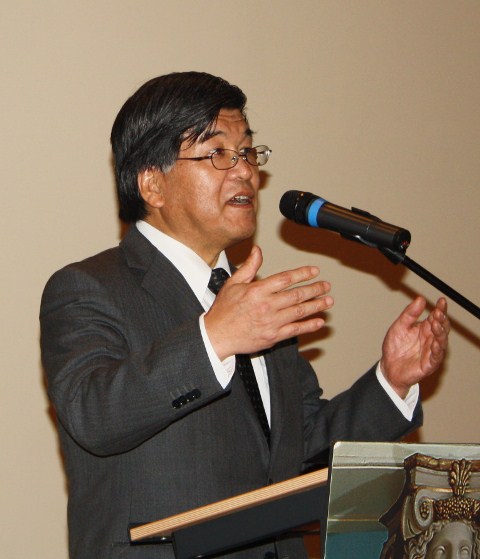 On March 11th, we held a reception to commemorate the third anniversary of the Great East Japan Earthquake. About 250 people, both Japanese and Belgian, gathered for the commemorative event held at the members-only club “Cercle Gaulois”. The guests prayed for the swift reconstruction of the affected areas. I once again expressed my gratitude for the many donations by the Belgian people after the disaster. During the event, a presentation was given by a representative of an NGO who provides support to the affected children of the region, and by two international school students who participated in an exchange programme. I believe it is important for people living together in society to not let this unprecedented catastrophe in modern Japan fade away, and for each to recall the happenings of three years ago. On March 11th, we held a reception to commemorate the third anniversary of the Great East Japan Earthquake. About 250 people, both Japanese and Belgian, gathered for the commemorative event held at the members-only club “Cercle Gaulois”. The guests prayed for the swift reconstruction of the affected areas. I once again expressed my gratitude for the many donations by the Belgian people after the disaster. During the event, a presentation was given by a representative of an NGO who provides support to the affected children of the region, and by two international school students who participated in an exchange programme. I believe it is important for people living together in society to not let this unprecedented catastrophe in modern Japan fade away, and for each to recall the happenings of three years ago.
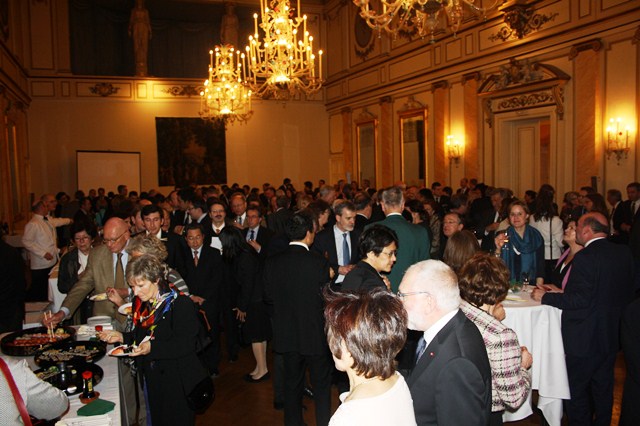 From among 260,000 people who evacuated their homes after the disaster more than 100,000 people are still living at present in temporary housing in the affected Tohoku area. More than 20,000 people have no choice but to give up hope of returning to their homes because of heavy contamination caused by the Fukushima nuclear accident. The debris left by the tsunami in the stricken area has almost been completely cleared, but the rebuilding of lives and the future disaster prevention measures to be taken have only just begun. Especially infrastructure improvement such as moving to higher grounds and constructing sea walls in the more than 300 coastal municipalities, and the decontamination of nuclear radiation in Fukushima might take five up to ten years. The reconstruction budget, estimated at 180 billion euro for five years after the earthquake is a big burden for the national and local governments. We are still a long way from calling the Great East Japan Earthquake an ‘incident of the past’. From among 260,000 people who evacuated their homes after the disaster more than 100,000 people are still living at present in temporary housing in the affected Tohoku area. More than 20,000 people have no choice but to give up hope of returning to their homes because of heavy contamination caused by the Fukushima nuclear accident. The debris left by the tsunami in the stricken area has almost been completely cleared, but the rebuilding of lives and the future disaster prevention measures to be taken have only just begun. Especially infrastructure improvement such as moving to higher grounds and constructing sea walls in the more than 300 coastal municipalities, and the decontamination of nuclear radiation in Fukushima might take five up to ten years. The reconstruction budget, estimated at 180 billion euro for five years after the earthquake is a big burden for the national and local governments. We are still a long way from calling the Great East Japan Earthquake an ‘incident of the past’.
< Carnival in Aalst >
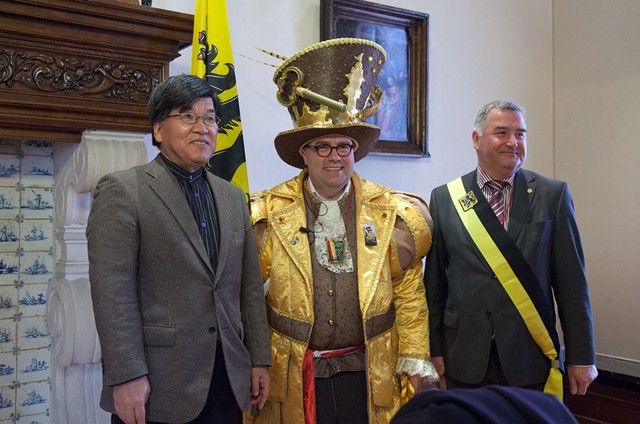 I only just visited the home of a Belgian friend who owns a lace atelier last month in Aalst (79,000 inhabitants), 30km to the west of Brussels (see Ambassador’s Chat no. 44), but this time I was invited by Mayor Christophe D’Haese on Sunday, the 2nd of this month to spectate one of Belgium’s most famous traditional cultural events, the Carnival of Aalst (held for the 86th time this year). The carnival is celebrated every year from the Sunday preceding Ash Wednesday (the first day of Lent) onwards for three days and is full of attractions worth seeing such as the carnival floats, the ‘throwing of onions’ and the costume parade. About 70 accredited groups and other private groups take part in the very long parade, marching through town and the Main Square. Many of the carnival groups are mocking politics and society with satirical floats, and some of them lack good taste a little. I had a VIP seat next to former President of the Chamber of Representatives, Herman De Croo (with a track record of 45 years as a member of parliament the longest and oldest active lawmaker) together with his son Vice Prime Minister Alexander De Croo. Not familiar with the situation in Belgium, many of the floats’ implications were unclear to me, but were thankfully explained to me by Mr. Herman De Croo. It being an outdoor event just at the start of spring, it became cold really quickly at the end of the day when the sun set. Not able to endure the cold, I was not able to stay until the end. I only just visited the home of a Belgian friend who owns a lace atelier last month in Aalst (79,000 inhabitants), 30km to the west of Brussels (see Ambassador’s Chat no. 44), but this time I was invited by Mayor Christophe D’Haese on Sunday, the 2nd of this month to spectate one of Belgium’s most famous traditional cultural events, the Carnival of Aalst (held for the 86th time this year). The carnival is celebrated every year from the Sunday preceding Ash Wednesday (the first day of Lent) onwards for three days and is full of attractions worth seeing such as the carnival floats, the ‘throwing of onions’ and the costume parade. About 70 accredited groups and other private groups take part in the very long parade, marching through town and the Main Square. Many of the carnival groups are mocking politics and society with satirical floats, and some of them lack good taste a little. I had a VIP seat next to former President of the Chamber of Representatives, Herman De Croo (with a track record of 45 years as a member of parliament the longest and oldest active lawmaker) together with his son Vice Prime Minister Alexander De Croo. Not familiar with the situation in Belgium, many of the floats’ implications were unclear to me, but were thankfully explained to me by Mr. Herman De Croo. It being an outdoor event just at the start of spring, it became cold really quickly at the end of the day when the sun set. Not able to endure the cold, I was not able to stay until the end.
< Brussels’ Art Deco Architecture >
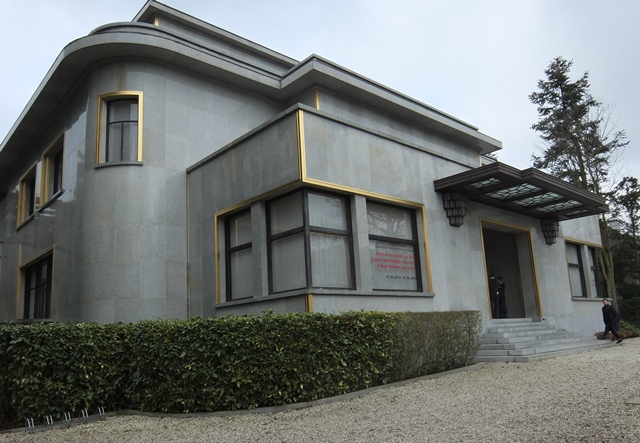 Avenue Franklin Roosevelt, where the Japanese Ambassador’s residence is located, is one of the main roads in southern Brussels. Because the avenue is lined with many beautiful buildings, such as embassies and ambassador’s residences, it is also called ‘Avenue des Ambassades’. Amongst those mansions is also an outstanding art deco villa just about 500m south of my residence. The building, named ‘Villa Empain’, was built by Swiss architect Michel Polak between 1930 and 1934 on request of Baron Louis Empain. It is considered one of the representative Art Deco buildings in Brussels with its gorgeous use of top-quality marble and splendour of building materials. Baron Empain, however, donated the building just a couple of years after it was finished to the Belgian government. During the Second World War it was confiscated by German troops and after the war it became the Embassy of the U.S.S.R. Later the building was even sold to a local radio and television station. In the 1990’s the house became unused and began to fall into decay. An Armenian man of considerable means, who recently bought the Villa, restored it almost completely and from 2010 onwards it is open to the public. This Armenian is the chairman of the Boghossian Foundation which strives to spread culture and welfare. The old Empain villa is now used as its main office as the ‘Centre for Art and Dialogue between the Cultures of the East and the West.’ Currently the centre holds a unique exposition called ‘A Book between Two Stools.’ I went to see the private viewing ten days ago (as I take an interest in the building). At the start of the thriving 20th century of Belgium, Art Nouveau architecture flourished in Brussels and many gorgeous buildings such as the UNESCO World Heritage appointed Horta Museum (by Victor Horta) and the Stoclet Palace (by Joseph Hoffmann) were built. However, also the architecture in the Art Deco period that came after the Great Depression of 1929 brought forth many amazing buildings. Brussels truly is a treasure-trove for young architects. Avenue Franklin Roosevelt, where the Japanese Ambassador’s residence is located, is one of the main roads in southern Brussels. Because the avenue is lined with many beautiful buildings, such as embassies and ambassador’s residences, it is also called ‘Avenue des Ambassades’. Amongst those mansions is also an outstanding art deco villa just about 500m south of my residence. The building, named ‘Villa Empain’, was built by Swiss architect Michel Polak between 1930 and 1934 on request of Baron Louis Empain. It is considered one of the representative Art Deco buildings in Brussels with its gorgeous use of top-quality marble and splendour of building materials. Baron Empain, however, donated the building just a couple of years after it was finished to the Belgian government. During the Second World War it was confiscated by German troops and after the war it became the Embassy of the U.S.S.R. Later the building was even sold to a local radio and television station. In the 1990’s the house became unused and began to fall into decay. An Armenian man of considerable means, who recently bought the Villa, restored it almost completely and from 2010 onwards it is open to the public. This Armenian is the chairman of the Boghossian Foundation which strives to spread culture and welfare. The old Empain villa is now used as its main office as the ‘Centre for Art and Dialogue between the Cultures of the East and the West.’ Currently the centre holds a unique exposition called ‘A Book between Two Stools.’ I went to see the private viewing ten days ago (as I take an interest in the building). At the start of the thriving 20th century of Belgium, Art Nouveau architecture flourished in Brussels and many gorgeous buildings such as the UNESCO World Heritage appointed Horta Museum (by Victor Horta) and the Stoclet Palace (by Joseph Hoffmann) were built. However, also the architecture in the Art Deco period that came after the Great Depression of 1929 brought forth many amazing buildings. Brussels truly is a treasure-trove for young architects.
< Tea-House and Buddha Statues >
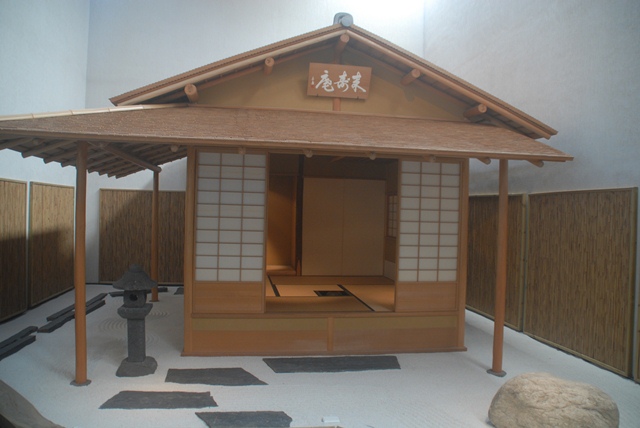 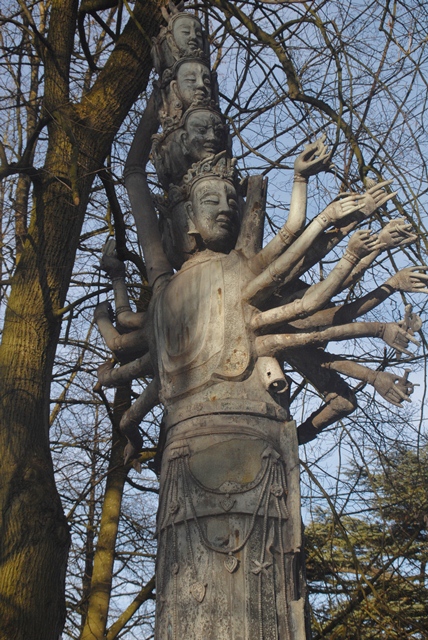 In the middle of a large park; the Grand Buddha and a statue of Kannon (the Goddess of Mercy); inside, an ‘Ukiyo-e’ woodblock print by Hiroshige Utagawa and a tea-house;… This unique place happens to be in Belgium. About 60km to the south of Brussels, just outside the small town of Morlanwelz, you can find the Royal Museum of Mariemont, which is said to have a first class art collection in Wallonia. Artefacts and works of art from ancient Egypt to Greek and Roman times are the main display, but also Chinese and Korean potteries, and porcelains as well as many objects that symbolize Japan as described above are on display. These are numerous artworks, collected in one generation by a local businessman, Mr Raoul Warocque, who made his fortune in the coal and steel industry from the late 19th century through the beginning of the 20th century. The 15ha Mariemont Park stems from the 16th century when Marie de Hongrie, who was the younger sister of Charles Quint, ruler of the Austro-Hungarian Empire, opened up the space for it to be used as hunting grounds. The origin of the place name Marimont means “Marie’s Mountain”. In the middle of a large park; the Grand Buddha and a statue of Kannon (the Goddess of Mercy); inside, an ‘Ukiyo-e’ woodblock print by Hiroshige Utagawa and a tea-house;… This unique place happens to be in Belgium. About 60km to the south of Brussels, just outside the small town of Morlanwelz, you can find the Royal Museum of Mariemont, which is said to have a first class art collection in Wallonia. Artefacts and works of art from ancient Egypt to Greek and Roman times are the main display, but also Chinese and Korean potteries, and porcelains as well as many objects that symbolize Japan as described above are on display. These are numerous artworks, collected in one generation by a local businessman, Mr Raoul Warocque, who made his fortune in the coal and steel industry from the late 19th century through the beginning of the 20th century. The 15ha Mariemont Park stems from the 16th century when Marie de Hongrie, who was the younger sister of Charles Quint, ruler of the Austro-Hungarian Empire, opened up the space for it to be used as hunting grounds. The origin of the place name Marimont means “Marie’s Mountain”.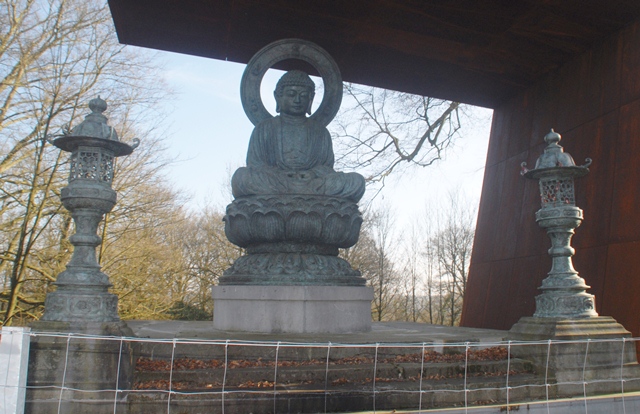 It was bought in the 19th century by the Warocque family, but because the family was left without a successor, it was donated to the Walloon government in 1991. It has only been since 1975 that the Warocque collection is open to the public as a museum. The seated statue of Amida Buddha was ordered by Raoul Warocque and built during his visit to Japan in 1910. The tea-house, which was on display during Europalia Japan, Belgium’s largest Japanese festival, was relocated here in 1989. It is truly amazing that a single Belgian had a collection of all these works of art and to have statues of Buddha from Japan displayed outdoors in the countryside, 60km from Brussels. It was bought in the 19th century by the Warocque family, but because the family was left without a successor, it was donated to the Walloon government in 1991. It has only been since 1975 that the Warocque collection is open to the public as a museum. The seated statue of Amida Buddha was ordered by Raoul Warocque and built during his visit to Japan in 1910. The tea-house, which was on display during Europalia Japan, Belgium’s largest Japanese festival, was relocated here in 1989. It is truly amazing that a single Belgian had a collection of all these works of art and to have statues of Buddha from Japan displayed outdoors in the countryside, 60km from Brussels.
|

